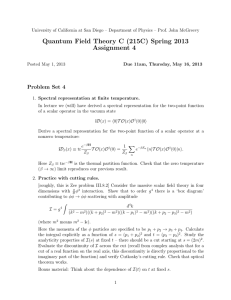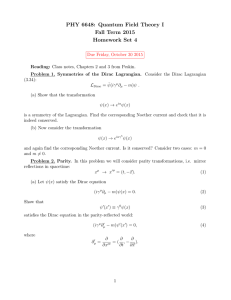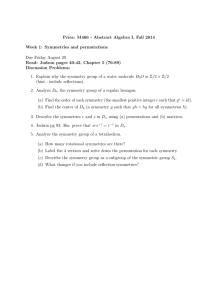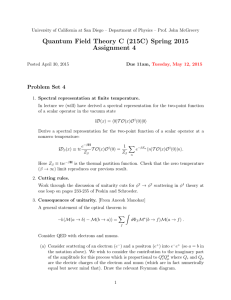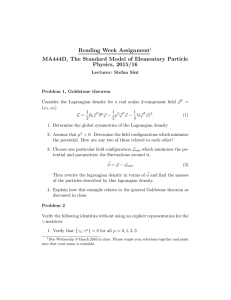2 (+ǫ) Dimensions Effective Lagrangians in
advertisement
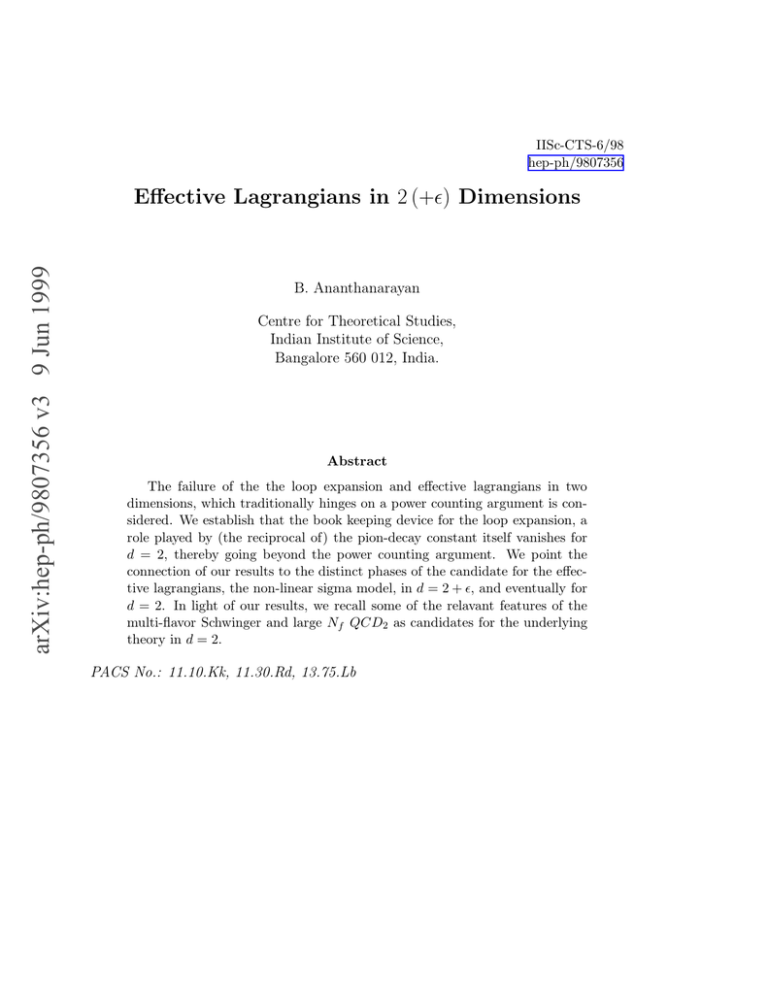
IISc-CTS-6/98 hep-ph/9807356 arXiv:hep-ph/9807356 v3 9 Jun 1999 Effective Lagrangians in 2 (+ǫ) Dimensions B. Ananthanarayan Centre for Theoretical Studies, Indian Institute of Science, Bangalore 560 012, India. Abstract The failure of the the loop expansion and effective lagrangians in two dimensions, which traditionally hinges on a power counting argument is considered. We establish that the book keeping device for the loop expansion, a role played by (the reciprocal of) the pion-decay constant itself vanishes for d = 2, thereby going beyond the power counting argument. We point the connection of our results to the distinct phases of the candidate for the effective lagrangians, the non-linear sigma model, in d = 2 + ǫ, and eventually for d = 2. In light of our results, we recall some of the relavant features of the multi-flavor Schwinger and large Nf QCD2 as candidates for the underlying theory in d = 2. PACS No.: 11.10.Kk, 11.30.Rd, 13.75.Lb 1 Introduction It has been argued [1, 2] that when a physical amplitude from Feynman diagrams using the most general Lagrangian that involves the relevant degrees of freedom and satisfies the assumed symmetries of the theory is calculated, then this amounts to writing down the most general amplitude that is consistent with the general principles of relativity, quantum mechanics and the assumed symmetries. This argument (which awaits a formal proof [3]), suitably generalized leads to the modern effective field theory of the low-energy strong interaction physics [4, 5] involving the pseudoscalar degrees of freedom, allowing for a loop-expansion. A power counting argument due to Weinberg that justifies the use of the effective lagrangians/loop expansion is a cornerstone of these techniques [1, 2]. The effective lagrangian at leading order is the non-linear sigma model with the pion decay constant Fπ playing the role of the (reciprocal of) the coupling constant. Furthermore, inverse powers of the pion decay constant play the role of a book keeping device for the loop-expansion. It has been noted that the power counting argument is general enough to admit an analysis in dimensions d 6= 4, and it follows from there that the loop-expansion fails in d = 2 [4]. A well-known result in d = 2, due to Coleman [6] and Mermin and Wagner [7], is that spontaneous symmetry breaking cannot occur. It has been pointed out that one of the original proofs provided for the Goldstone mechanism [8], breaks down for d = 2 [6], which follows from the impossibility of defining a massless scalar field theory [9, 10, 11] for d = 2. The latter result is rigorously true, as it is based on the underlying Wightman functions of field theory. Also it might be legitimate to take the following point of view: the Coleman-Mermin-Wager theorem says that there are no Goldstone bosons in d = 2 and as a result it is not necessary to speak of an effective field theory. In constrast, we have found it more fruitful to examine the foundations of the programme of effective lagrangians. Here, we shall show that the impossibility of defining a massless scalar field in d = 2 implies that Fπ , the book keeping device of the loop expansion vanishes identically, thereby providing a new insight for the failure of the effective lagrangian technique in d = 2, and which is independent of the loop expansion. This is the main conclusion of the present work. We note that our proof will be valid only in the case of non-anomalous currents that interpolate between the vacuum and the candidates for the one-pion occupation number states. A careful discussion of all the underlying assumptions of the program, and an investigation of the manner in which they breakdown in d = 2 is presented, and the 2 properties of the underlying theory and that of the effective theory separately. In what follows the results do not particularly depend on whether the symmetries are actually the axial vector symmetries, or whether the Goldstone bosons are actually the pions. We shall, however, stick to the standard terminology, since no confusion is likely to arise. In Section 2 we discuss the foundations of effective lagrangians and the power counting argument. We recount the main assumptions and examine all the assumptions critically and comment on possible generalizations. In Section 3 we revisit the Goldstone mechanism with emphasis on the causes of its breakdown for d = 2, by studying more than one proof of the theorem. A central result we present here is that the phenomenological pion-decay constant has to vanish identically in this case. We also discuss the relationship of our result with the established results for the non-linear sigma model for d = 2 + ǫ and for d = 2. In Section 4 we examine the implications of our results, to some candidates for the underlying theory such as the Schwinger and large Nf QCD2 models. In Section 5 we summarize our conclusions. 2 Effective Lagrangians and Power Counting We consider the case of massless QCD with two quark flavors with the spontaneous breakdown of chiral SU(2)L × SU(2)R to SU(2)V . The Goldstone theorem then requires that the following identity be verified: h0|Aµi (x)|π a (p)i = ipµ Fπ δia eip·x √ (2π)3/2 2 p0 (2.1) where the Ai are the currents associated with the broken generators and the π a are the three pions, and Fπ (≃ 184 MeV in four dimensions) is the phenomenological pion decay constant. We will later see that the “pion” is merely required to be a single-particle occupation number state, which transforms as a (pseudo-)scalar under the Lorentz transformation; the “pion-decay constant” will essentially stand for a measure of the probability amplitude for a current to interpolate between the vacuum and a one-particle occupation number state. The statements above may easily be generalized to the breakdown of a symmetry G → H, where G and H are global symmetries associated with underlying theory, the “pions” resulting from its (possibly unknown) dynamics of the underlying theory. There may be no a priori guide to knowing what H could be and how the pion-decay constant(s) could be related to the parameters of the underlying theory. We will also treat equations of 3 the type given in eq. (2.1) as the equation to define the pion decay constant matrix, in the case of a generalized breakdown G → H. It will also not be necessary to refer to any generator as being broken or not; in general, the number of currents will be the dimension of the group of symmetries and the number of “pion” states can also be as large as the dimension of the group. In this work, we shall show that all pion-decay constants in the sense described above vanish in d = 2. At leading order, the identify eq. (2.1) is reproduced, due to the Lie-algebra isomorphism between SU(2) × SU(2) and O(4), by the non-linear O(4) sigma model lagrangian, L(2) , 1 ∂µ~π ∂ µ~π L(2) = − (2.2) 2 (1 + ~π 2 /Fπ2 ) This yields the first term of the derivative expansion, at O(p2 ), which is a term of O(1/Fπ2). This follows from the expression for the Noether current ~µ A = Fπ " 2~π (~π · ∂ µ~π ) (1 − ~π 2 /Fπ2 ) + ... + ∂ ~π (1 + ~π 2 /Fπ2 ) Fπ2 (1 + ~π 2 /F 2 ) # µ (2.3) associated with the invariances of the model, described in great detail in Chapter 19 of Ref.[2] (see also Ref. [12]). It must be noted that the coupling constant of the sigma model defined by the equation abovis 1/Fπ2 . Some additional remarks are in order: (a) the structure of the symmetry alone, and the assumption that Goldstone bosons are present in the spectrum dictate the form of L(2) and is therefore valid in arbitrary dimensions. We note, however, that in the case of axial-vector symmetries there is something of a conflict, since γ5 is defined only in even dimensions. Our point of view is one where the underlying theory is considered to be well defined in a given space-time dimension and the corresponding effective lagrangian is constructed in that dimension and then continued to d → 2, and (b) the expression for the Noether current is obtained by treating the Lagrangian around its perturbative vacuum, which assumes that the interactions of the model do not alter the spectral assumptions, viz., that the pions are present in the spectrum as massless particles, and furthermore, and this is important for our considerations, that the expansion parameter of the model 1/Fπ2 remains perturbative. The power counting analysis corresponding to the low energy expansion of the path integral is based on the observations that (a) Goldstone bosons have only derivative couplings and each derivative brings in a power p of the momentum, (b) that each loop in d dimensions brings in the momentum pd powers of momentum from dd p integral in the loop, and (c) that each internal line brings in p−2 powers of 4 the momentum from the p2 term in the denominator of the propagator. Thus the presence of a vertices Vi of order di , in an arbitrary diagram γ with L loops and I internal lines, are associated with the contribution to the generating functional of order O(pOγ ), where X Oγ = Vi di + dL − 2I. (2.4) i One may eliminate I through the use of the topological identity L=I− X Vi + 1, (2.5) i to obtain Oγ = X i Vi (di − 2) + (d − 2)L + 2. (2.6) This shows clearly why in d = 4 at tree-level where there is only one type of vertex of order 2 and no loops, the chiral power counting produces contributions of O(p2), and why the loops are suppressed by two powers of the momentum. The argument above leads in general to a power-counting that facilitates a low-energy expansion of Green’s functions in the powers of the momenta based on non-renormalizable lagrangians. An attempt to work out the theory at one-loop level leads to divergences, which are then absorbed in the parameters of a new lagrangian L(4) . The Green’s functions of the currents computed with this lagrangian are then accurate at O(p4); it is also easy to see that the expansion is also one is powers of Fπ−2 . Note that the loops of L(2) account for terms of O(p4 ). Setting d = 2 shows that the loops are not suppressed [4] and thus the effective lagrangian analysis which start with only tree-level contributions cannot work in d = 2. In what follows, we shall show the apparent failure of the loop-expansion can infact be traced to the absence of an expansion parameter; the pion-decay constant itself will vanish and an expansion in powers of Fπ−2 is ill-defined. This result is derived from an analysis of the underlying Wightman functions of field theory and is independent of any lagrangian analysis. Whereas it has been recognized that the field parameterization independence of effective lagrangian techniqes [13] have analogs from results in axiomatic field theory due to Haag [14], our results unfortunately do not provide such an analog in arbitary dimensions to the discussion of Ref. [4], where the justification for program of effective field theory is carried beyond those of current algebra, and is provided in terms of a direct analysis of the Ward identities of QCD via the generating functional technique. 5 3 The Goldstone Mechanism Revisited The failure of the Goldstone mechanism in 2 dimensions was demonstrated by considering one of the proofs and exhibiting the precise manner in which is fails, which we briefly recapitulate. In the notation of Ref. [6], consider a scalar field theory described by a local scalar field φ and if jµ is a conserved current, then the scalar field defined by Z δφ(y) = i dd−1 x[j0 (x0 , x), φ(y)], (3.1) where the integration is over the spatial dimensions, is such that its vacuum expectation value, for the Goldstone mechanism to succeed, should differ from zero, i.e., h0|δφ(0)|0i = 6 0. (3.2) In 2 dimensions, however, it can be shown that this integral must vanish. This is related to the fact that the Wightman function: d2 k ik·x 2 e δ(k )θ(k0 ) (3.3) 2π fails to be well-defined, where η(x) describes a free massless scalar field satisfying the equation 2η = 0. In other words, it is not possible to define a free massless scalar field theory in two dimensions, and that the Feynman propagator in two dimensions ∆F (x − y) is also not well-defined. Of the two proofs of the Goldstone mechanism in general that were proposed in Ref. [8], the second proof of Ref. [8] considered the effective action Γ[φ] and imposed on it the condition of invariance. Here we consider, in the notation of Ref. [2], the case of the invariance of a field theory described by a set of hermitian fields (possibly composite) φn , subjected to the linear infinitesimal transformations h0|η(x)η(0)|0i = Z φn (x) → φn (x) + g α (tα )m n φm (x) (3.4) γ [tα , tβ ] = ifαβ tγ (3.5) where the tα are the generators of the underlying symmetry and the g α are the parameters that parametrize an infinitesimal transformation. The symmetry is completely described the by commutation relations of the algebra given by γ where the fαβ are the structure constants of the algebra. The set of conserved currents associated with the symmetries Jαµ (x) are such that: ∂µ Jαµ (x) = 0 6 (3.6) and the corresponding charges are which satisfy the algebra Z dd−1 xJα0 (x) (3.7) γ [Qα , Qβ ] = ifαβ Qγ . (3.8) Qα = We also have the the transformation law: [Qα , φn (x)] = (tα )nm φm (x), (3.9) leads us to the consideration of the “order parameter matrix” of vacuum expectation values Cαm = (−i)h0|[Qα , φm (x)]|0i (3.10) The assumption of translational invariance then implies the following statement for the effective potential with Γ[φ] = −VV (φ), where V is the space-time volume: ∂V (φ) α m g (tα )m n φ = 0. ∂φn (3.11) Taking a second derivative of this expression with respect to the field, and the assumption that the potential is minimized for φn 6= 0, (viz, that the symmetry is spontaneously broken) then implies: ∂ 2 V (φ) α g (tα )m n φm = 0. ∂φ ∂φ n l n,m X (3.12) In order for this equation to be satisfied, the matrix ∂ 2 V (φ) ∂φn ∂φl must have zero eigenvalues, whose eigenvectors would be inverse propagators for massless scalar fields. However, as noted earlier in d = 2 the corresponding propagators are ill-defined. It then follows that the assumption φn = 0 we made in the first place is wrong and this implies that the Goldstone mechanism fails. This proof, however does not yield the desired result. A third proof of the Goldstone mechanism, is the consequence of a Ward identity [12]. This is shown by considering the following time ordered product: Fαµm (x) = h0|T Jαµ (x)φm (0)|0i 7 (3.13) which satisfies the following equation for its divergence: ∂µ Fαµm (x) = δ(x0 )h0|[Jα0 (x), φm (0)]|0i (3.14) The assumption of current algebra that the commutation rules hold at the local level, viz., n [Jα0 (x), φm (0)] = δ (d−1) (x)[Qα , φm (0)] = −δ (d−1) (x)(tα )m n φ (0), (3.15) leads to the Ward identity n ∂µ h0|T Jαµ (x)φm (0)|0i = −δ d (x)(tα )m n h0|φ (0)|0i. (3.16) The Fourier transform of Fαµm (x), F̃αµm (p) then obeys the equation: n m (−i)pµ F̃αµm (p) = −(tα )m n h0|φ (0)|0i = iCα (3.17) From Lorentz invariance, F̃αµm (p) must have a pole at p2 = 0. This implies the existence of massless bosons, the pions π a . The number of pions depends on the characteristics of the order parameter matrix, viz. the residual symmetry. One may also define the following matrix elements h0|Jαµ (x)|π a (p)i = Gma e−ip·x ipµ Fαa eip·x a m p p (p)|φ (x)|0i = , hπ , (3.18) (2π)(d−1)/2 2 p0 (2π)(d−1)/2 2 p0 [we have reserved the symbol Fπ for the case of QCD] which is then related related to the order parameter matrix eq.(3.10) Nπ X Fαa Gma = Cαm (3.19) a=1 A crucial assumption that goes into the construction above, is the existence of oneparticle occupation number states, which furnish a representation for the Lorentz group, and must transform as (pseudo-)scalars, in order to not break Lorentz invariance. [The absence of such states would not allow us to even define the matrix elements of interest to us, and Fπ in particular would remain undefined.] This assumption can then be translated to a field renormalization prescription by which Gam 6= 0 can be held fixed. This proof, however, breaks down in d = 2 since in the intermediate step, eq. (3.16), the vacuum expectation of the commutator encountered with arbitrary scalar operator φm , where φm is only required to transform as 8 a Lorentz scalar, and vanishes due to a generalization of eq.(3.2). This must imply that the constants Cαm for the choice must be zero. As an illustration, let us consider the case in d > 2 of the O(N) linear model broken down to O(N − 1) through the vacuum expectation value of the direction (1, 0, ...0) of a scalar multiplet transforming in the vector representation of O(N). It has been shown in Ref. [2] that for this case, the following maybe established: Fba = δba F , Gab = δ ab G, a, b = 2, ..., N, and that all other pion-decay constants and field renormalization constants vanish. [here there is only one pion-decay constant]. The only non-vanishing Cαm then are those of the structure F Gδab . However, for d = 2, these too would have to vanish. Note once more that a field renormalization prescription has to be available in order to render the |π a (p)i to be well-defined. Thus, since G is held fixed, we must therefore have, F = 0. In the above, the discussion may as well have been for QCD, with the scalar field that acquires a vacuum expectation value replaced by an appropriate composite operator therein, and upon further specializing the discussion to the O(4) case (alternatively the SU(2) × SU(2) case, with the currents Jα now identified with the axial vector currents Ai ) we see that Fπ (d = 2) = 0 (3.20) as required. This proof, however, cannot be extended for the general case, where little is known about the structure of the entries of the pion-decay constant matrix and the field renormalization prescription matrix elements Gam . A final proof we consider that avoids taking a recourse to the field renormalization prescription arises when we consider the spectral representation for products of currents: X N δ d (p − pN )h0|Jαµ(0)|Nih0|Jβν (0)|Ni∗ = (2π)1−d θ(p0 ) × (i) h (1) (0) i η µν − pµ pν /p2 ραβ (−p2 ) + pµ pν ραβ (−p2 ) , (3.21) where the ραβ , i = 0, 1 are spectral densities. Taking the Fourier transform and using the completeness of the states |Ni, this can be written as: h0|Jαµ (x)Jβν (0)|0i = h (1) (0) (1) Z dµ2 i × η µν ραβ (µ2 ) − ραβ (µ2 ) + ραβ (µ2 )/µ2 ∂ µ ∂ ν ∆+ (x; µ2 ), where 1 ∆+ (x; µ ) = (2π)d−1 2 Z dd pθ(p0 )δ(p2 + µ2 ) exp(ip · x) 9 (3.22) (3.23) It may then be easily shown, using current conservation (viz., only for non-anomalous currents) that X (0) ραβ (−p2 ) = δ(−p2 ) Fαa Fβ∗a . (3.24) a Indeed, it has been pointed out in Ref.[6] that a delta-function singularity is forbidden on the light-cone in momentum space in d = 2 for scalar fields, which in turn P implies that the matrix K whose elements are given by a Fαa Fβ∗a vanishes identically1 , in order to render eq. (3.24) meaningful. The matrix K is real symmetric due to the vanishing of the commutator h0|[Jαµ (x), Jβν (0)]|0i for space-like separations, and furthermore, the one-particle basis |π a (p)i can always be rotated in such a manner that the pion-decay matrix whose elements Fαa may be brought to a real diagonal form [4] such that Fαa = δαa F(α) . In this basis, it is easy to see that (0) ραβ (−p2 ) = δ(−p2 )F(α) F(β) δ αβ . (3.25) At this point, we shall pick this basis and it is then, a straightforward exercise to demonstrate that the F(α) all vanish. This proves our proposition. What can then be said about the non-linear sigma model and the currents of the non-linear sigma model in the light of the above? In the case of the O(N) non-linear sigma model, for d = 2+ǫ, it is known that the model exhibits a phase transition [15, 16]. A weakly coupled phase which is one where the system is in the spontaneously broken phase; it is precisely this phase which is required to reproduce, say eq. (2.2) for N = 4 and serves as the effective theory for an underlying theory with Goldstone bosons. Since the coupling constant of the non-linear sigma model is Fπ−2 , the weak coupling phase is one the in which Fπ2 cannot approach zero. A second phase exists, which is a strongly coupled one with a bound state σ particle which is mass degenerate with the “pions,” and the model can no longer be the effective low energy lagrangian of QCD in d = 2 + ǫ. The collective modes of the resulting model have been extensively studied, and the model now realizes the complete O(N) symmetry linearly [15]. In d = 2, only the strongly coupled phase is realized in accordance with our findings. Another manner in which these results can be qualitatively understood is that loops are unsuppressed, and even if a classical minimum is chosen in the linear sigma model which breaks the symmetry, the effective potential restores the symmetric minimum [17]. R Constrast this with, in the notation of Ref. [6], d2 x expik·x h0|jµ (x) φ(0)|0i = σkµ δ(k 2 )θ(k0 )+ ǫµν k ν ρ(k 2 )θ(k0 ), where σ is a numbers and ρ is a scalar distribution. Here the first term is welldefined due to the taming of the infra-red singularity residing in the delta-function by kµ . As a result, the proof that σ must vanish, is non-trivial [6]. 1 10 4 Underlying theories in 2 dimensions It has been known for sometime that gauge theories in d = 2 exhibit interesting and important properties. The best studied example is the Schwinger model [11]; massless QED is d = 2 with one flavor which exhibits confinement, charge screening ˜ symmetries. The and chiral symmetry breaking, associated with the U(1) × U(1) symmetries of interest to us in the present work, are those associated with Nf flavors, and in particular the SU(Nf )L × SU(Nf )R symmetry, which remains unbroken as expected [18]. For the case of two flavors, the theory has been again been recently studied [19] in somewhat greater detail and the interactions associated with the socalled “analog pions” and “analog sigma” that realize the O(4) symmetry that is associated with this flavor symmetry. The results here remain in accordance with our findings. Another interesting class of models are those based on SU(Nc ) gauge symmetry, with the fermions transforming in the fundamental representation and with Nf flavors. These provide a category of underlying theories that reflect our own, viz., QCD. These models have been widely studied in the context of non-abelian bosonization [20]. The limit Nc → ∞, Nf = 1 is the well-known ’t Hooft model [21] which has no spin-zero bosons. The latter theory has been solved exactly in the large Nc limit and does not warrant a low energy analysis. A massless, multi-flavor version of this model has been considered with Nc fixed and Nf → ∞ [22], whose spectrum simplifies to one that is Nc2 − 1 copies of the abelian spectrum. Here, it is clear that the SU(Nf )L × SU(Nf )R symmetry remains explicitly unbroken. 5 Conclusions A detailed analysis of the failure of the Goldstone mechanism in d = 2, first encoded by the Coleman and Mermin and Wagner theorem, reveals through the analysis of the Ward identities and spectral representations of the correlation functions of currents, that the phenomenological pion-decay constant(s) must vanish. In this manner, the would be effective lagrangian whose structure is fixed by the symmetries and the reciprocal of the pion-decay constant, for d = 2 + ǫ goes into a strongly coupled (and indeed for ǫ = 0 exists only in a symmetry restored) phase, thereby vindicating the heuristic power counting argument that says that effective lagrangians must fail as we near d = 2 for theories with pions. Our work shows the latter can essentially be justified on formal grounds in field theory. Our work is also consistent with re11 sults established in the past concerning global flavor symmetries in exactly solvable models, including the multi-flavor Schwinger model as well as large Nf QCD2 . Acknowledgments: The hospitality of the International Centre for Theoretical Physics, Trieste, Italy and of the Institut für Theoretische Physik, Universität Bern, Bern, Switzerland where part of this work was completed is gratefully acknowledged. It is a pleasure to thank N. D. Hari Dass, P. Hasenfratz, H. Leutwyler, P. Minkowski, S. Naik, V. P. Nair, A. D. Patel, S. Randjbar-Daemi, D. Sen, C. S. Shukre and K. Sridhar for discussions. I thank D. Sen for useful remarks on the manuscript. References [1] S. Weinberg, Physica 96 A, 327 (1979). [2] S. Weinberg, The Quantum Theory of Fields, Volume II Modern Applications, Cambridge University Press, Cambridge, UK, (1996). [3] See, e.g., S. Weinberg, hep-ph/9702027. [4] H. Leutwyler, Ann. Phys. 235, 165 (1994). [5] J. Gasser and H. Leutwyler, Ann. Phys. 158, 142 (1984). [6] S. Coleman, Comm. Math. Phys. 31, 259 (1973). [7] N. D. Mermin and H. Wagner, Phys. Rev. Lett. 17, 1113 (1966). [8] J. Goldstone, A. Salam and S. Weinberg, Phys. Rev. 127, 965 (1962). [9] B. Schroer, Fortsch. der Physik 11, 1 (1963). [10] A. S. Wightman in High Energy Electromagnetic Interactions and Field Theory, M. Levy, ed., Gordon and Breach, New York, 1967. [11] E. Abdalla, M. C. B. Abdalla and K. D. Rothe, Non-perturbative methods in 2 dimensional Quantum Field Theory, World Scientific, Singapore, 1991, and references therein. [12] J. Gasser and H. Leutwyler, Effective Field Theories, Cambridge University Press, Cambridge, UK, (to be published). 12 [13] S. Coleman, J. Wess and B. Zumino, Phys. Rev. 177, 2239 (1969). [14] R. Haag, Phys. Rev. 112, 669 (1958). [15] W. A. Bardeen, B. W. Lee and R. E. Shrock, Phys. Rev. D 14, 985 (1976). [16] E. Brézin and J. Zinn-Justin, Phys. Rev. Lett. 36, 691 (1976). [17] S. Coleman, R. Jackiw and H. D. Politzer, Phys. Rev. D 10, 2491 (1974). [18] L. V. Belvedere, J. A. Sweica, K. D. Rothe and B. Schroer, Nucl. Phys. B 153, 112 (1979). [19] D. Delphnich, J. Schechter and S. Vaidya, Phys. Rev. D 59, 056004 (1999). [20] Y. Frishman and J. Sonneschein, Phys. Rep. 223, 309 (1993). [21] G. ’t Hooft, Nucl. Phys. B 75, 461 (1974). [22] A. Armoni, Y. Frishman, J. Sonnenschein and U. Trittmann, Nucl. Phys. B 537, 503 (1999). 13


